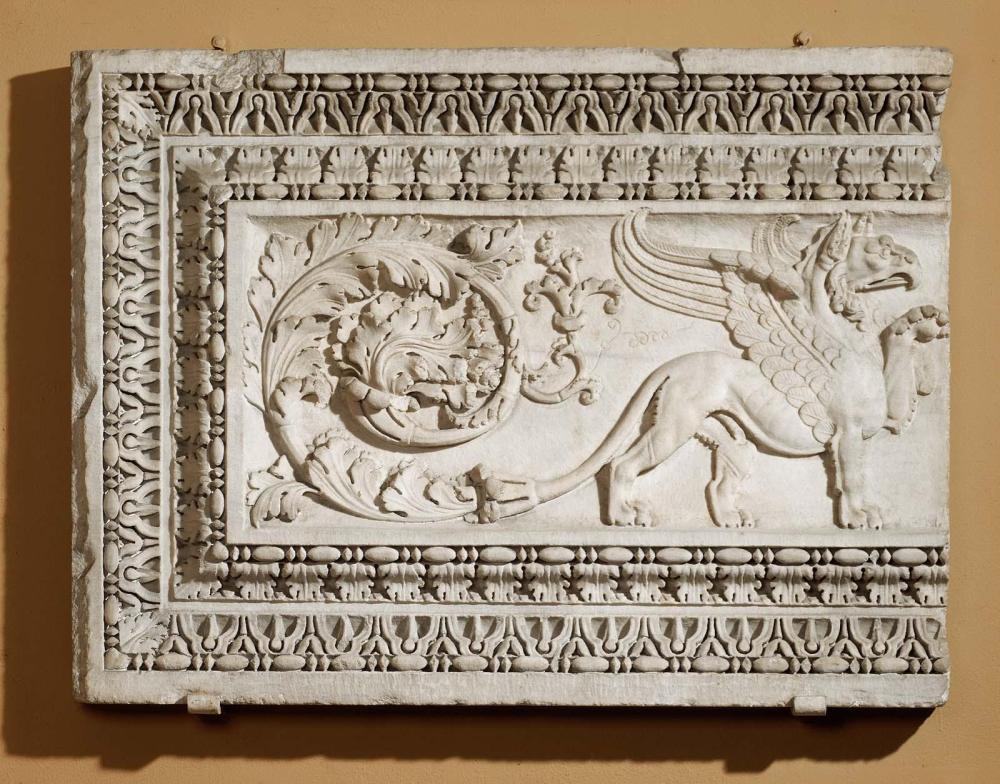Advanced Search 

Architectural panel with a griffin
Roman
Imperial Period
about A.D. 175–200
Place of Manufacture: Italy, Campania
Medium/Technique
Marble, probably from the from the island of Proconnesus in the Sea of Marmara near Istanbul
Dimensions
Height x length: 104 x 139.2 cm (40 15/16 x 54 13/16 in.)
Credit Line
Bartlett Collection—Museum purchase with funds from the Francis Bartlett Donation of 1900
Accession Number03.747
NOT ON VIEW
CollectionsAncient Greece and Rome
ClassificationsArchitectural elements
Griffins were monsters with the bodies of lions and the heads and wings of eagles. Ancient writers recount that in the mountains of northeastern Europe (presumably the area of modern Russia), griffins guarded abundant gold and fought off the Arimasps, one-eyed men who tried to steal their treasures. On the strength of this legend, griffins came to be considered protective beings and were often shown in sacred contexts, on temples and religious objects.
This marble panel representing a griffin in relief is one of a pair in the MFA's collection. The two panels, each framed by Classical architectural moldings, originally decorated a building and feature two griffins facing in opposite directions. The beasts may once have flanked a candelabrum, reproducing a pattern seen on the frieze that wraps around the temple of Emperor Antoninus Pius and his wife, Faustina, at Rome, erected in A.D. 141 and still partly preserved. On the Boston panels, the griffins' tails metamorphose into vines sprouting massive acanthus leaves, creating a sense of nature in bloom and adding an extra touch of fantasy to these benevolent mythological monsters.
This marble panel representing a griffin in relief is one of a pair in the MFA's collection. The two panels, each framed by Classical architectural moldings, originally decorated a building and feature two griffins facing in opposite directions. The beasts may once have flanked a candelabrum, reproducing a pattern seen on the frieze that wraps around the temple of Emperor Antoninus Pius and his wife, Faustina, at Rome, erected in A.D. 141 and still partly preserved. On the Boston panels, the griffins' tails metamorphose into vines sprouting massive acanthus leaves, creating a sense of nature in bloom and adding an extra touch of fantasy to these benevolent mythological monsters.
Catalogue Raisonné
Sculpture in Stone (MFA), no. 305; Sculpture in Stone and Bronze (MFA), p. 113 (additional published references); Highlights: Classical Art (MFA), p. 160.
DescriptionThis relief together with 03.748 presented griffins confronting one another on either side of a central element. The composition would have had sacred and protective connotations and may have formed part of the decoration of a temple. It is also possible that the reliefs embellished a large funerary structure or a secular public building, such as a basilica or market hall.
An eagle-griffin stands with one paw raised and the central element was probably a candelabrum. The griffin's tail turns into a rich acanthus vine, which sends out a lateral shoot and terminates in a cluster of leaves. The frame consists (from inside out) of an astragal, a row of acanthus leaves with intervening leaf tongues, a Lesbian cymation, and an astragal.
The panel is incomplete at the right end, where it has been cut off vertically. The outer, rectangular frame is somewhat damaged. It originally would have been paired with 03.748.
An eagle-griffin stands with one paw raised and the central element was probably a candelabrum. The griffin's tail turns into a rich acanthus vine, which sends out a lateral shoot and terminates in a cluster of leaves. The frame consists (from inside out) of an astragal, a row of acanthus leaves with intervening leaf tongues, a Lesbian cymation, and an astragal.
The panel is incomplete at the right end, where it has been cut off vertically. The outer, rectangular frame is somewhat damaged. It originally would have been paired with 03.748.
ProvenanceBy 1903: with Edward Perry Warren (according to Warren's records: From Torre Annunziata. Bought in Sorrento [with 03.748]; a letter from Warren, dated January 18, 1928, adds that he was told the relief with griffins had been on the wall of the cathedral of Sorrento and had been taken down when a new front was put up, the relief then being in private possession for some time); purchased by MFA from Edward Perry Warren, March 24, 1903
